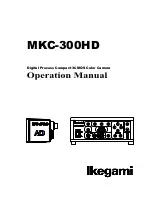
13
The Trigger mode is selected in software and determines the trigger source, gate source, and whether
the exposure time is controlled by the camera’s or the user’s electronics. Table 1 shows which
configuration corresponds to each Trigger Mode.
External Trigger Port
Triggering the Intensified Retiga Fast 1394 can be done in one of two ways: Synchronous Integration
Mode or User Controlled Integration Mode.
In Synchronous Integration Mode, an edge on the trigger pin of the External Trigger Port is interpreted
as a trigger event. If the camera is not busy when a trigger event is detected, an exposure will be
triggered after a trigger delay (see the section on Trigger Delay for more information). Figure 11
shows a timing diagram of the camera's operation in this mode.
In User Controlled Integration Mode, the level on the trigger pin of the External Trigger Port controls
the CCD's electronic shutter directly. That is, the shutter is open for the duration that the pulse is
active. If the camera is busy, it will ignore the pulse. Figure 12 shows a timing diagram of the camera's
operation in this mode.
Gate Input
The Gate Input of the Intensified Retiga Fast 1394 is a BNC connector that accepts fast negative TTL
pulses. This port is electrically isolated from the camera's electronics. See Appendix B for further
information and schematics of the Gate Input.
The Gate Input is only used in User Controlled Integration Mode. In this mode, the Gate Input
explicitly controls the Image Intensifier Tube Gate.
Trigger Delay
The Trigger Delay is the delay between an external trigger event and the start of exposure. The
Intensified Retiga Fast 1394 allows the user to control the Trigger Delay in software. User control over
the Trigger Delay facilitates easy synchronization of the camera's exposure with external events.
The Trigger Delay is valid only in some Trigger Modes as shown in Table 1.
Содержание Intensified Retiga Fast 1394
Страница 1: ......













































